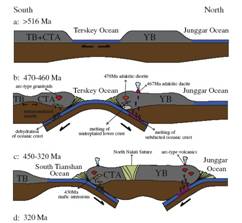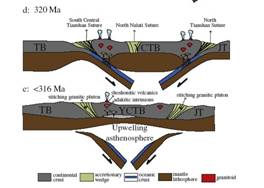Geochemical and Geochronological Studies of Granitoid Rocks from the Western Tianshan Orogen Implications for Continental Growth in the Southwestern Central Asian Orogenic Belt
2011-12-12
The Central Asian Orogenic Belt (CAOB) also known as the ‘Altai tectonic collage’ is one of the world's largest accretionary orogens. The Western Tianshan Orogen in northwestern China is part of the southwestern CAOB, which represents the largest tectonic assembly of accretionary complexes and the most significant area of Phanerozoic continental growth in the world. But Compared with granitoids in other parts of the CAOB, the isotopic characteristics and ages of rocks exposed in the Tianshan Orogen, which occupies the southwest margin of the CAOB.
Therefore, researchers used two different models to explain the mechanism of the Phanerozoic continental growth in the Western Tianshan Orogen: the ‘syn-subduction continental growth by accretion of arc complexes related to oceanic subduction’ and the ‘syn-subduction lateral continental growth by accretion of arc complexes as well as post-collisional vertical continental growth by accretion of mantle-derived material’.
The findings showed that granitoid rocks have a widespread occurrence and occupy about 30% of the whole exposure of the orogen. Ages obtained for the granitoids vary from 896 Ma to 247 Ma, while initial 87Sr/86Sr ratios vary from 0.70329 to 0.72070 and εNd values from -14.1 to+7.3. The occurrence of Neoproterozoic granitic gneisses implies the presence of Precambrian basement in this area. During oceanic subduction, continental growth occurred as a result of several combined processes, i.e. by addition of oceanic crustal melts (adakites), the intrusion of basaltic magmas derived by partial melting of the metasomatized depleted mantle wedge and the upwelling of granitic magma derived from a mixed source of basaltic magmas and old continental basement. However, during the post-collisional period, vertical accretion of underplated juvenile mantle material may have been accomplished during ‘slab breakoff’ delamination. This study suggests a two stage model of continental growth of ‘syn-subduction lateral accretion of arc complexes’ and ‘post-collisional vertical accretion of underplated mantle material’, which may also be relevant for the western segment of the CAOB in the Phanerozoic. The reworking and involvement of old crust are more obvious in the Western Tianshan Orogen compared to other parts of the CAOB comprising the Western Junggar, Eastern Junggar, Alataw and Altay terranes.
This study was supported by the State Key Project for Basic Research of China, the National Natural Science Foundation of China, China Geological Survey and the DFG. This work has been published on Lithos, 2011, 126(3-4): 321-340. The paper is also archived at http://www.sciencedirect.com/science/article/pii/S0024493711002106.
|
|
|
Tectonic model showing the evolution and the continental growth mechanism of the Western Tianshan Orogen. TB: Tarim Block, CTA: Central Tianshan Arc, YB: Yili Block, JT: Junggar Terrane, YCTB: Yili-Central Tianshan Block.





